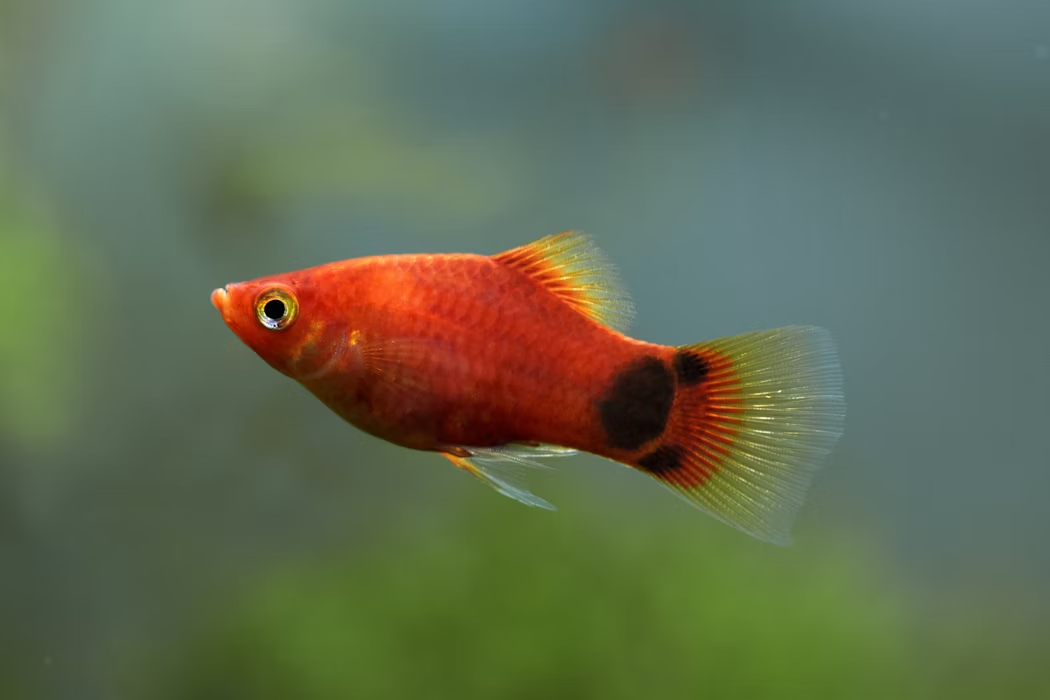Xiphophorus maculatus
Platy

Scientific Classification
Quick Stats
Aquarium Building Information
About This Species
Basic Description
Detailed Description
Native to the slow-moving freshwater streams, canals, and marshes of North and Central America, this species has adapted to environments with gentle water flow and plentiful vegetation. Replicating this natural habitat is key to their long-term health in a home aquarium. A tank with ample live plants serves multiple purposes: it mimics their native biome, provides security, and offers refuge for fry, as these fish breed prolifically. They prefer neutral to alkaline water that is moderately hard, reflecting the mineral content of their original environment.
As highly social, shoaling animals, they should never be kept alone. A group allows them to feel secure and display their full range of natural behaviors. They are perpetually active, inhabiting every level of the water column from the substrate to the surface. This active nature, combined with a medium metabolism, requires daily feeding. A true omnivore, its diet in the wild consists of small insects, crustaceans, worms, and plant matter. In captivity, this should be replicated with a high-quality staple flake or pellet, supplemented with diverse offerings like frozen bloodworms, brine shrimp, and blanched vegetables to ensure complete nutrition. They are also known to graze on biofilm and algae, contributing to the tank's cleanliness.
Physiologically, they are quite robust. Their low oxygen consumption and moderate waste production make them a manageable addition to a properly maintained system. While they are a true freshwater species, they exhibit a slight tolerance for low levels of salinity, a trait that speaks to their adaptability in coastal or estuarine-adjacent native habitats. With their relatively short lifespan, providing a stable, clean, and enriching environment is crucial for them to live out their full, active lives.
Scientific Description
Xiphophorus maculatus is a small, freshwater teleost belonging to the family Poeciliidae, an order known for its live-bearing reproductive strategy. Its native distribution spans North and Central America, where it typically inhabits lentic or slow-lotic environments such as ditches, canals, and warm springs. The species displays a preference for hard, alkaline waters, a characteristic consistent with the geological composition of its native limestone-rich regions.
The morphology is characterized by a fusiform body shape, which is hydrodynamically efficient for its active swimming behavior. Sexual dimorphism is pronounced. Males are generally smaller and more slender than females and are distinguished by a modified anal fin known as a gonopodium, which is used for internal fertilization. Females are larger, have a more rounded abdominal region, and possess a standard, fan-shaped anal fin.
Ecologically, X. maculatus is an opportunistic omnivore. Its diet includes detritus, algae, small crustaceans, and aquatic insects. As a biofilm consumer, it plays a role in the primary and secondary trophic levels of its ecosystem. Due to its wide distribution and stable population, its IUCN Red List status is currently designated as Least Concern (LC). Physiologically, the species is characterized by a medium metabolic rate, low oxygen consumption, and a moderate bioload factor. It exhibits a notable euryhaline capacity for a predominantly freshwater fish, with a documented tolerance for low-end brackish conditions. This adaptability has contributed to its success as an introduced species in various parts of the world. Its reproductive method is ovoviviparous, where females retain fertilized eggs internally, giving birth to free-swimming, fully developed young.
Breeding Description
Breeding this species is considered exceptionally easy, and it will often reproduce in a standard community aquarium without any special intervention. Success begins with a healthy, well-conditioned group of adults. It is crucial to be able to distinguish between the sexes to maintain a proper ratio. Males are identifiable by their modified anal fin, which is pointed and rod-like, called a gonopodium. Females are typically larger and more rounded in the body, with a traditional, fan-shaped anal fin. To prevent stress and relentless pursuit of a single female, a recommended ratio of at least two or three females to every one male should be maintained.
As live-bearers, these fish practice internal fertilization. After a gestation period of approximately four to six weeks, the female will give birth to live, free-swimming fry. A single brood can consist of anywhere from 20 to 80 young. The adults exhibit no parental care and will readily cannibalize their own offspring. To ensure a high survival rate for the fry, two primary methods can be employed. The first is to provide an abundance of dense hiding places within the main aquarium, such as thickets of fine-leaved plants like hornwort or java moss, which offer natural cover. The second, more controlled method, is to move a gravid (pregnant) female to a separate, dedicated breeding tank just before she is due to give birth. Once the fry are born, the female should be returned to the main aquarium immediately.
The newborn fry are independent from birth and must be fed appropriate foods. Their diet should consist of microscopic-sized meals such as infusoria, liquid or powdered fry food, and newly hatched brine shrimp. As they grow, they can be transitioned to finely crushed fish flakes. Frequent, small feedings throughout the day are essential for their rapid growth and development.
Related Images

Mickey Mouse Platy
Generate Printable Card
Create a printable card for this creature to display in your store or aquarium. The card includes a QR code for quick access to more information.




